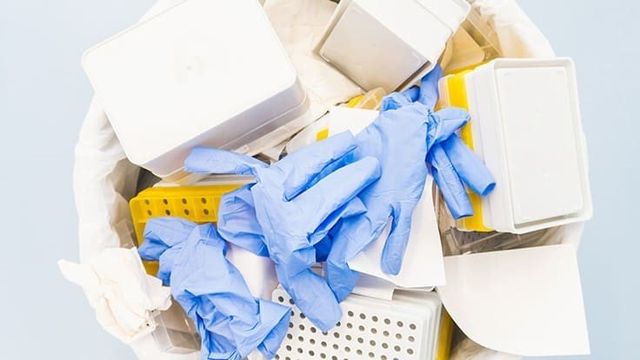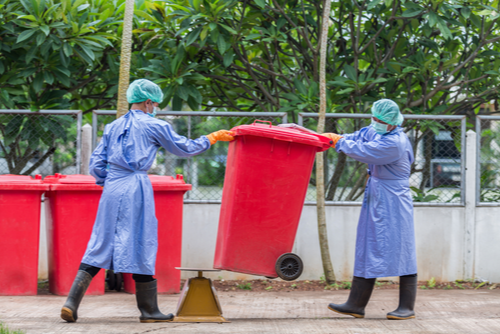Proactive Health Solutions: Picking the very best Medical Waste Removal Near You
Proactive Health Solutions: Picking the very best Medical Waste Removal Near You
Blog Article
The Significance of Appropriate Clinical Waste Disposal: A Guide for Medical Care Facilities
Proper clinical garbage disposal is a critical element of health care center administration, guaranteeing the safety and health of people, staff, and the setting. From understanding the various groups of medical waste to complying with regulative requirements, healthcare centers should adopt reliable waste partition practices and choose ideal disposal techniques. The importance of appropriate medical waste disposal goes beyond plain compliance; it is a responsibility that needs recurring training and education for personnel. In this guide, we will check out the different facets of clinical waste disposal and highlight the essential steps that medical care centers ought to take. By applying these practices, healthcare centers can minimize risks, safeguard public health and wellness, and add to a cleaner, safer atmosphere.
Understanding Clinical Waste Categories
Comprehending clinical waste groups is crucial for proper disposal in healthcare centers. Medical waste is a wide term that incorporates various sorts of waste created in healthcare settings, such as facilities, health centers, and research laboratories. Classifying clinical waste assists ensure that it is dealt with, saved, and disposed of safely and according to relevant laws.
There are numerous classifications of clinical waste that medical care facilities require to be familiar with. These classifications consist of contagious waste, sharps waste, pharmaceutical waste, chemical waste, and radioactive waste (medical waste disposal services with WasteX). Each group has particular characteristics and needs different disposal techniques to lessen the risk of harm to health care employees, people, and the environment
Contagious waste, for instance, refers to throw away infected with possibly contagious products, such as blood, body liquids, and cells. Sharps waste consists of needles, syringes, and other sharp things that can cause injury or transmit infections. Pharmaceutical waste is composed of run out or extra medications, while chemical waste contains unsafe chemicals used in clinical procedures. Finally, contaminated waste includes products polluted with contaminated materials, such as nuclear medication products.
Conformity With Regulatory Demands
Health care facilities must ensure conformity with regulatory demands for appropriate medical garbage disposal. Regulative bodies, such as the Epa (EPA) and the Occupational Safety and Health And Wellness Management (OSHA), have developed regulations and standards to safeguard public health and the setting. These policies lay out the correct handling, storage space, transportation, and disposal of clinical waste.
Conformity with regulative needs is crucial for health care facilities to stay clear of lawful charges, reputational damage, and possible harm to human wellness and the setting. Failing to adhere to these guidelines can result in fines, legal actions, and even the suspension or abrogation of operating licenses.
To make certain compliance, medical care centers should establish thorough waste administration programs that include personnel training, correct waste segregation, and the usage of ideal containers and tags. Normal audits and assessments should also be performed to identify any non-compliance concerns and address them without delay.
It is necessary for healthcare facilities to keep up to day with changes in guidelines and update their waste monitoring practices as necessary. This can be attained by proactively keeping an eye on updates from regulatory bodies and joining training programs and workshops.
Applying Effective Waste Partition Practices
To guarantee appropriate clinical waste disposal, healthcare centers should apply reliable waste segregation methods. Waste segregation is a crucial step in the total waste management process, as it helps reduce the danger of infection, avoids cross-contamination, and makes certain the secure disposal of various sorts of waste. Effective waste partition practices involve separating medical waste into different groups based upon its features and possible risks.
One typical technique is the partition of sharps waste, such as needles and scalpels, from various other medical waste disposal services with WasteX kinds of clinical waste. Sharps waste need to be positioned in puncture-resistant containers to avoid injuries and potential infections. Additionally, hazardous waste, such as chemicals and drugs, must be divided from general medical waste to stop environmental contamination.
Correct labeling and color-coding of waste containers are essential for reliable waste segregation. Clear and visible tags must be put on each container to suggest the kind of waste it consists of and any kind of unique handling requirements - medical waste disposal services with WasteX. Furthermore, color-coding can be used to separate between different waste classifications, making it much easier for healthcare personnel to check my site get rid of and recognize of waste correctly
Routine training and education and learning for healthcare staff is important for the successful execution of waste segregation methods. Team member need to be enlightened on the different waste classifications, correct segregation techniques, and the significance of complying with waste monitoring methods. This will certainly help ensure conformity and uniformity in waste segregation methods throughout the center.
Choosing Appropriate Disposal Techniques
Appropriate choice of ideal disposal methods is necessary in ensuring the safe and ecologically accountable management of medical waste in health care centers. Health care facilities generate a variety of medical waste, including sharps, transmittable waste, pharmaceutical waste, and chemical waste - medical waste removal services. Each kind of waste calls for certain disposal techniques to reduce the danger of contamination, injury, and ecological damage
One usual disposal technique for medical waste is incineration. Incineration includes the regulated burning of waste at high temperature levels.

Chemical sanitation is an additional method utilized for sure kinds of medical waste, such as pharmaceutical waste. This technique utilizes chemicals to counteract or damage impurities. However, it is very important to pick chemicals that are ecologically pleasant and risk-free.
Sometimes, land fill disposal might be suitable for non-hazardous clinical waste (medical waste disposal services with WasteX). Appropriate segregation and product packaging are critical to prevent leak or contamination.
Inevitably, healthcare centers should carefully assess the features of their medical waste and choose ideal disposal techniques that focus on safety, environmental management, and governing compliance. Regular training and monitoring are important to make sure that healthcare team complies with proper disposal protocols.

Training and Educating Personnel on Appropriate Disposal Procedures
Staff education and training play a vital look here role in making certain the correct disposal of clinical waste in health care facilities. It is vital that all personnel members, including medical professionals, nurses, technicians, and assistance staff, obtain extensive training on appropriate disposal procedures. This training should cover the various kinds of clinical waste, their potential threats, and the proper techniques for handling, segregating, and throwing away them.
One of the key objectives of team education and learning and training is to make certain that all health care professionals understand the importance of correct disposal procedures and the prospective repercussions of inappropriate waste management. They require to be familiar with the dangers connected with clinical waste, such as the transmission of infections and the contamination of the setting. medical waste removal. By understanding these dangers, personnel will certainly be extra inspired to adhere to appropriate disposal protocols and take the essential safety measures to safeguard themselves, their associates, and the community
Training should likewise cover using personal protective tools (PPE) and the correct techniques for dealing with clinical waste. Employee need to be informed on how to identify and segregate various kinds of waste, such as sharps, transmittable waste, and dangerous chemicals. They must additionally be trained on the correct usage of waste containers, such as sharps containers and biohazard bags, along with the value of labeling and sealing these containers correctly.
Moreover, personnel education and learning and training ought to consist of regular updates and refresher programs to make certain that medical care experts stay notified regarding the most recent policies and finest methods in medical garbage disposal. This ongoing education is crucial to maintain a high degree of awareness and compliance amongst team members.
Conclusion
In conclusion, appropriate medical waste disposal is of utmost value for medical care centers. Recognizing the various categories of medical waste and abiding with governing requirements makes sure the safety and security and wellness of both health care workers and the basic public.
From understanding the different classifications of medical waste to complying with regulatory demands, health care centers need to take on effective waste segregation techniques and pick suitable disposal techniques. These groups include contagious waste, sharps waste, pharmaceutical waste, chemical waste, and contaminated waste.To make sure proper medical waste disposal, healthcare centers must apply reliable waste partition methods. Waste segregation is a vital step in the total waste administration process, as it aids reduce the risk of infection, prevents cross-contamination, and makes sure the safe disposal of various types of waste. Health care centers create a range of clinical waste, including sharps, infectious waste, pharmaceutical waste, and chemical waste.
Report this page